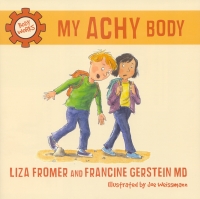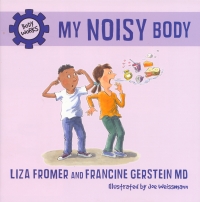| ________________
CM . . . . Volume XVIII Number 10 . . . . November 4, 2011
excerpt:
Co-written by a broadcast journalist and a family physician, the four-title "Body Works" series is designed to help youngsters to understand how various body systems work. Each book describes the purpose of specific body parts, the causes and treatments of common ailments, such as a sore throat, and the differences between adults and children in terms of recovery. One example is that kids with broken bones heal faster than adults do because children's osteoblasts (bone-building cells) are more active. All of the books begin with photos of the other titles in the series and an author's note. A double-page spread is devoted to each subtopic, with fun facts, a true or false question and a doctor's tip for good health. Initials "MT" appearing on a page indicate a medical term. The authors' casual, conversational writing style is well suited to their purpose of explaining complex concepts in an age-appropriate way.
My Achy Body features the workings of the central nervous system. In this title, readers will find out about the ways in which the body deals with pain, bruises, scrapes, scabs, bone fractures, sprains, strains, stomach aches, earaches and sore throats. Readers likely will have experienced many, if not most, of these conditions. In My Messy Body, the purpose of the body's secretions is discussed. Readers will cringe at, but find interesting, the gross topics, including mucus, earwax, sweat, snot, pus, pee, poo and vomit. By the authors describing the various topics in a matter-of-fact way, the "grossness" and embarrassment of the topic is dissolved. Another subject in this title is tears, their composition, production and usefulness. My Noisy Body primarily highlights the digestive system but also examines sneezes and coughs. The digestive system begins with the mouth where the vocal cords, tongue and teeth (along with the nose) produce sound or voice. Readers will also learn about burps, hiccups, stomach growls and farts (another gross topic that gets treated matter-of-factly) and what kinds of sounds the doctor hears with a stethoscope. Growth is the main focus of My Stretchy Body. There is information about the composition of hair, its growth phases and its function, depending on where it is on the body, skin, nails, muscles, bones and the different types of teeth. A Midparental Height calculation provides a gender-specific formula that will enable children to predict their adult height. This formula is given in both inches and centimeters. Generally, the series' strengths lie in the demystification of body systems, the idea that even the "gross" workings of the body are normal and nothing to be embarrassed about, and the appealing illustrations. Very interesting, fun and educational. Recommended. Gail Hamilton is a former teacher-librarian in Winnipeg, MB.
To comment
on this title or this review, send mail to cm@umanitoba.ca.
Copyright © the Manitoba Library Association. Reproduction for personal
use is permitted only if this copyright notice is maintained. Any
other reproduction is prohibited without permission.
NEXT REVIEW |
TABLE OF CONTENTS FOR THIS ISSUE
- November 4, 2011.
AUTHORS |
TITLES |
MEDIA REVIEWS |
PROFILES |
BACK ISSUES |
SEARCH |
CMARCHIVE |
HOME |




 However, according to the publisher, the target audience for this series is much younger (ages 6-9). Children of this age group would need a parent's or a teacher's assistance in order to read and fully comprehend some of the vocabulary and the concepts. Even the glossary vocabulary is too advanced for young readers. For instance, the definition of "virus" is given as "a microscopic infectious agent than can only replicate in a living cell." As well, there is a bit of a contradiction in terms of the cover and the illustrations. The cover would likely attract a younger audience, but the cartoon-like watercolour and ink drawings tend to depict older children. Illustrations are colourful, highly appealing and add a touch of humour to the text. Both males and females are represented in the illustrations of physicians.
However, according to the publisher, the target audience for this series is much younger (ages 6-9). Children of this age group would need a parent's or a teacher's assistance in order to read and fully comprehend some of the vocabulary and the concepts. Even the glossary vocabulary is too advanced for young readers. For instance, the definition of "virus" is given as "a microscopic infectious agent than can only replicate in a living cell." As well, there is a bit of a contradiction in terms of the cover and the illustrations. The cover would likely attract a younger audience, but the cartoon-like watercolour and ink drawings tend to depict older children. Illustrations are colourful, highly appealing and add a touch of humour to the text. Both males and females are represented in the illustrations of physicians.